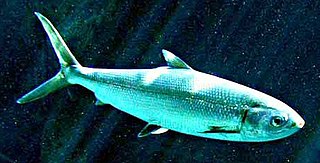
Chanidae is a family of fishes which has a number of fossil genera and one monotypic extant genus which contains the milkfish.
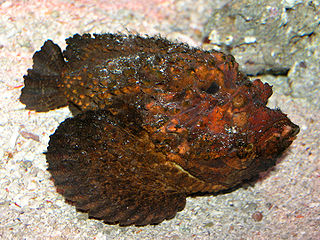
Synanceiinae is a subfamily of venomous ray-finned fishes, waspfishes, which is classified as part of the family Scorpaenidae, the scorpionfishes and their relatives. These fishes are found in the Indo-Pacific oceans. They are primarily marine, though some species are known to live in fresh or brackish waters. The various species of this family are known informally as stonefish, stinger, stingfish and ghouls. Its species are known to have the most potent neurotoxins of all the fish venoms, secreted from glands at the base of their needle-like dorsal fin spines. The vernacular name, stonefish, for some of these fishes derives from their behaviour of camouflaging as rocks. The type species of the family is the estuarine stonefish.

Anthias are members of the family Serranidae and make up the subfamily Anthiinae. The name Anthiidae is preoccupied by a subfamily of ground beetles in the family Carabidae created by Bonelli in 1813 and this grouping should be called the Anthiadinae. However, both the 5th Edition of Fishes of the World and Fishbase give the Serranid subfamily as "Anthiinae".

Trichogaster is a genus of gouramis native to South Asia from Pakistan to Myanmar. It is the only genus in the monotypic subfamily Trichogastrinae as set out in the 5th Edition of Fishes of the World, although that book states that there are two genera, the other being Colisa which is treated as a synonym of Trichogaster by Fishbase and the Catalog of Fishes. Fishbase also places the genus in the Luciocephalinae. Species of this genus are very popular in the aquarium trade.
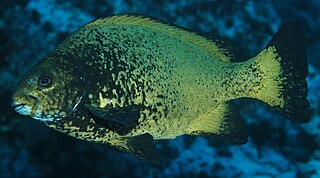
The sea chubs, also known as rudderfish and pilot fish and in Hawaiian as enenue or nenue, are a family, Kyphosidae, of fishes in the order Perciformes native to the Atlantic, Indian and Pacific Oceans usually close to shore in marine waters.

Caranginae is a subfamily of ray-finned fish from the family Carangidae which consists of twenty genera and 103 species.

Tincinae is a subfamily of freshwater ray-finned fish from the family Cyprinidae, it consists of the tench of Eurasia and the east Asian clod minnows.

Phallostethidae, also known as the priapium fish, is a family of atheriniform fish native to freshwater and brackish habitats in southeast Asia.

Cypsellurinae is a subfamily of flying fishes, one of four in the family Exocoetidae and the only one which is not monogeneric.

Trachinotinae is a subfamily of the family Carangidae, the jacks and pompanos.

Scomberoidinae is a subfamily of ray-finned fish from the family Carangidae which consists of three genera and 10 species. The species in this subfamily have been given the common names leatherjacket and queenfish.

Lepominae is a subfamily of freshwater ray-finned fish, one of three subfamilies in the family Centrarchidae, the sunfishes.

Centrarchinae is a subfamily of freshwater ray-finned fish, one of three subfamilies in the family Centrarchidae, the sunfishes.

Romanichthyini is a tribe of freshwater ray-finned fish which is one of two tribes in the subfamily Luciopercinae, which in turn is classified under the family Percidae, the family also includes the perches, pikeperches, ruffes and darters.
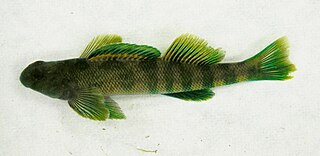
Etheosomatidae is a species-rich subfamily of freshwater ray-finned fish, the members of which are commonly known as the darters. The subfamily is part of the family Percidae which also includes the perches, ruffes and pikeperches. The family is endemic to North America. It consists of three to five different genera and well over 200 species.

Paradicichthyinae is a subfamily of marine ray-finned fishes, one of four subfamilies classified within the family Lutjanidae, the snappers.

Sebastolobini is a tribe of marine ray-finned fishes belonging to the subfamily Sebastinae of the family Scorpaenidae in the order Scorpaeniformes. Many species have the common name thornyhead.
Anoplagoninae is a subfamily of marine ray-finned fishes belonging to the family Agonidae, part of the sculpin superfamily Cottoidea. These fishes are found in the North Pacific Ocean.
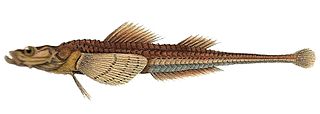
Brachyopsinae is a subfamily of marine ray-finned fishes belonging to the family Agonidae, part of the sculpin superfamily Cottoidea. These fishes are found in the North Pacific Ocean.
Bathyagoninae is a subfamily of marine ray-finned fishes belonging to the family Agonidae, part of the sculpin superfamily Cottoidea. These fishes are found in the Pacific and Atlantic Oceans.


















